Why should you consider getting the best wireless meat thermometer for smokers or even open grills? The journey to becoming a grill master is long, and sometimes even hard. What kind of a grill to use? Where to buy the meat? Coal, gas, or electric? Cast iron, steel, or ceramics? These are all questions you have asked yourself at least once during a cookout. The correct temperature affects the final flavor as much as the ingredients do.
People often underestimate the importance of heat monitoring by using inaccurate gear, or by ignoring it altogether. However, a few degrees here and there can make all the difference in the world when it comes to a good juicy steak, or even mushrooms and veggies. No matter the skill level, you will always benefit from a reliable thermometer. Let’s see what these thermometers have to offer!
See The Quick Comparison Chart
Advantages of Wireless Meat Thermometers
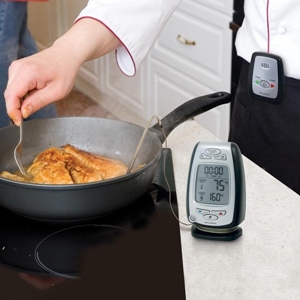 Just by knowing what a wireless thermometer can bring to the table, you can already tell what kind of advantages to expect, and there are plenty. After all, the thermometer is the one to say when to start and when to finish the cookout.
Just by knowing what a wireless thermometer can bring to the table, you can already tell what kind of advantages to expect, and there are plenty. After all, the thermometer is the one to say when to start and when to finish the cookout.
1. Punctuality
If you want your meat to taste great, you will not play the guessing game every time, but invest in precision instead. Knowing the exact temperature of your grill, grill grate, and the meat itself is putting you one step closer to not only tastier but healthier food as well. You may have not tasted the difference of 20 degrees when it comes to cooking beef yet, but with a device like a solid thermometer, you will most certainly start tasting it.
2. Budget
Another great advantage that people seem to overlook every time is money saving. This especially goes for anyone using a charcoal kamado grill or an outdoor gas griddle. The amount of money you will save by not going over the desired temperature is quite substantial. We all know the problem of overheating the grill and having to wait for it to cool off. That takes forever, and then you have to wait and regulate the heat again, and so on, and so on. You get the picture. By measuring the temperature instantly, you get to completely control how hot your grill is going to burn. This way, you will not only save money on saved grill fuel but a lot of time as well.
3. Time
Speaking of time, having a wireless thermometer enables better time distribution. All you have to do is set the wanted temperature and/or time, and go do other chores, mingle or simply watch TV. When the time comes, or the temperature is achieved, the thermometer will send you a notification. With a measurement tool like this, you do not need to hover around your grill like a helicopter. Once you master the device, you will notice that everything goes faster with the grill cookouts.
4. Health
Lastly, one of the biggest advantages a good thermometer provides is the health benefits. A lot of people like to grill and smoke chicken, and we all know that chicken needs to be handled properly because of the bacteria. A lot of people like to eat their beef a bit rare, and the golden zone of a grilled crust and juicy steak insides is achieved via accurate temperature monitoring. Of course, you will also be able to prevent overly burning the meat, thus preventing additional charring of the food. A lot of that crisp on a steak is proved to be unhealthy and slightly carcinogenic.
Generally, people opt-in and get a wireless meat thermometer for the biggest advantage there is convenience. No walking around the grill the whole time, and smoking meat becomes care-free. So, you get to save money and time and to prepare healthier food. No wonder even the most-experienced chefs around the globe use these devices. We as humans cannot tell temperature differences that well, so why not invest in a smart tool that can do that for you?
Best Wireless Meat Thermometers Comparison Chart
| PRODUCT | DETAILS | ||
|---|---|---|---|
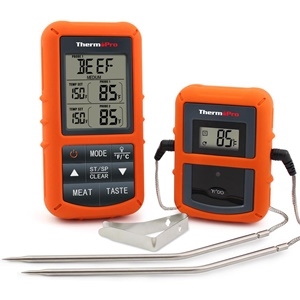 | THERMOPRO TP20 WIRELESS MEAT THERMOMETER |
| View On Amazon |
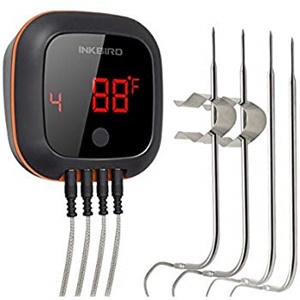 | INKBIRD IBT-4XS BLUETOOTH WIRELESS MEAT GRILL THERMOMETER |
| View On Amazon |
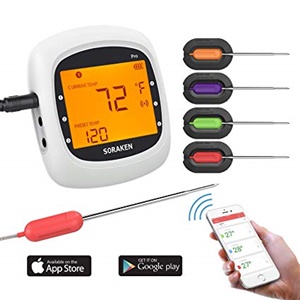 | SORAKEN GM-001 BLUETOOTH WIRELESS MEAT THERMOMETER |
| View On Amazon |
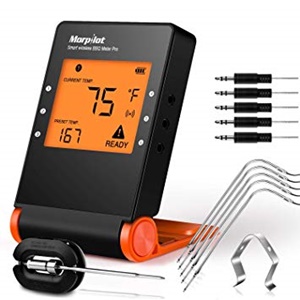 | MORPILOT BLUETOOTH WIRELESS MEAT THERMOMETER |
| View On Amazon |
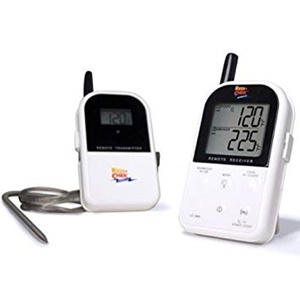 | MAVERICK ET-732 REMOTE BBQ SMOKER THERMOMETER |
| View On Amazon |
Best Wireless Meat Thermometer For Smokers Reviews
1. ThermoPro TP20 Wireless Meat Thermometer
 First off, we have a popular model from ThermoPro. Their TP20 is designed to look industrial and modern at the same time, with its smooth edges and black and orange color finish. The whole set contains 2 stainless steel sensor probes, a transmitter with a small LCD screen for single probe checkup, and a receiver. This means that you will not need a mobile phone to use it.
First off, we have a popular model from ThermoPro. Their TP20 is designed to look industrial and modern at the same time, with its smooth edges and black and orange color finish. The whole set contains 2 stainless steel sensor probes, a transmitter with a small LCD screen for single probe checkup, and a receiver. This means that you will not need a mobile phone to use it.
The probes are slightly curved, allowing better positioning, and they can withstand temperatures as high as 716 degrees Fahrenheit. The receiver is slightly bigger than the transmitter and it comes with the option to program an alarm, or a heat/time reminder. The LCD screen of the receiver is backlit, and you can also read the temperatures from both probes, live. There are also two additional buttons, allowing you to chose preset programs for the kind of meat and the taste you want to achieve.
Total wireless range of the unit is around 300 feet, and the accuracy of the probes varies for up to 1.8 degrees.
2. Inkbird IBT-4XS Bluetooth Wireless Meat Grill Thermometer
 Next up, we have a futuristic-looking model from Inkbird. This thermometer is supposed to be used with a mobile phone as a receiver. It has smooth edges, and dark black, glossy design with the option to stick to any surface (using a magnet), making it look great in any kitchen or yard. In the set, you can find 4 stainless steel probes with heat-resistant cables, a transmitter, and a USB charging cable.
Next up, we have a futuristic-looking model from Inkbird. This thermometer is supposed to be used with a mobile phone as a receiver. It has smooth edges, and dark black, glossy design with the option to stick to any surface (using a magnet), making it look great in any kitchen or yard. In the set, you can find 4 stainless steel probes with heat-resistant cables, a transmitter, and a USB charging cable.
The transmitter is charged via the USB cable (using a computer or a USB charger) and it has a battery of 1000 mAh capacity (lasts up to 60 hours). It is connected to your mobile phone via Bluetooth technology, with an average range of 50 feet. All you have to do is download the app and pair the device with your phone. The app offers a lot of integrated preset programs for different kinds of meat.
The probes on this model are slightly curved for easier setup, and they can withstand up to 572 degrees Fahrenheit, with a narrow margin of error of about 1 degree up or down.
3. Soraken GM-001 Bluetooth Wireless Meat Thermometer
 Here we have another modern-looking model by Soraken. The GM-001 is minimalistic in its design, with a small transmitter module and color-coded sensor probes. The role of a receiver falls on your mobile phone or tablet, but the temperature can be tracked via a backlit LCD screen on the transmitter, although only one probe can be monitored this way.
Here we have another modern-looking model by Soraken. The GM-001 is minimalistic in its design, with a small transmitter module and color-coded sensor probes. The role of a receiver falls on your mobile phone or tablet, but the temperature can be tracked via a backlit LCD screen on the transmitter, although only one probe can be monitored this way.
Using Bluetooth technology, you can connect the device to your phone and download the app that provides a wide range of cooking, grilling and smoking programs and presets for various types of meat. The total range you can reach via this technology is around 100 yards, or slightly more if you are outside.
The probes measure temperature accurately in the range from 32 to 572 degrees Fahrenheit, although they can withstand up to 726 degrees of heat. The strong suit of this model is the super-resilient Teflon cables that connect the probes to the transmitter.
4. Morpilot Bluetooth Wireless Meat Thermometer
 Another Bluetooth connected thermometer, this time from Morpilot, captured our interest. The unique thing about this thermometer model is its incredibly compact design that can fit anywhere. The set contains 4 stainless steel probes, a transmitter module, 2 claw-like clips, and a metal ambient temperature reading clip, ideal for using a probe when smoking meat.
Another Bluetooth connected thermometer, this time from Morpilot, captured our interest. The unique thing about this thermometer model is its incredibly compact design that can fit anywhere. The set contains 4 stainless steel probes, a transmitter module, 2 claw-like clips, and a metal ambient temperature reading clip, ideal for using a probe when smoking meat.
The transmitter supports up to 6 probes at a time, and it comes packed with a backlit LCD screen that allows you to track a single probe at a time. The other probes are meant to be monitored via your smartphone, using a free app provided by the manufacturer. They also installed a lot of presets for various meat types and left the option for you to program the device to your needs.
The manufacturer claims that the probes can work indefinitely, and in the case any single probe breaks, they will replace it, free of charge.
5. Maverick Et-732 Remote Bbq Smoker Thermometer
 Coming up next, with a little more traditional approach is the Et-732 from Maverick. Both the receiver and the transmitter are made to resemble small radios, painted white. The set contains a couple of stainless steel probes, a transmitter and a receiver. The communication technology involved uses radio waves, which have a wider range than Bluetooth, and it reaches up to 300 feet.
Coming up next, with a little more traditional approach is the Et-732 from Maverick. Both the receiver and the transmitter are made to resemble small radios, painted white. The set contains a couple of stainless steel probes, a transmitter and a receiver. The communication technology involved uses radio waves, which have a wider range than Bluetooth, and it reaches up to 300 feet.
On the transmitter, there is a small LCD that can track a single probe temperature at a time, while the receiver can display both sensor probes live. The programming of this model is slightly simpler than the rest from its class, and it allows you to adapt the temperature ratings to the type of meat, and the degree you want your meet heated to. There is also an alarm option installed for the timers, and the LCD screen on the receiver is backlit for extra convenience.
The probes are durable and can measure temperatures up to 572 degrees Fahrenheit with great precision.
6. Nutrichef Smart Bluetooth Meat Thermometer Wireless Remote
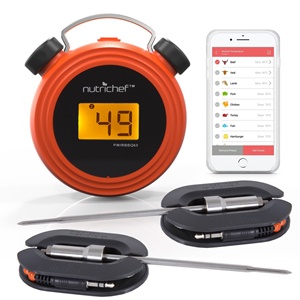 This is the most compact wireless meat thermometer on our list, and it comes from Nutrichef. The set contains 2 stainless steel probe sensors and a transmitter module. This module weighs only 2.4 ounces and it is designed to somewhat look like an old alarm clock, with a black and orange color finish.
This is the most compact wireless meat thermometer on our list, and it comes from Nutrichef. The set contains 2 stainless steel probe sensors and a transmitter module. This module weighs only 2.4 ounces and it is designed to somewhat look like an old alarm clock, with a black and orange color finish.
Although you can read a single probe temperature from the installed backlit LCD screen on the side of the transmitter, this unit provides you with a wide set of various options when you connect it to a smartphone or a tablet. The app is pretty intuitive to use and easily programmable, with provided time and temperature alarms.
This model of a meat thermometer is ideal for beginners, due to its simple design and affordability. The probes measure grill and meat temperatures accurately in the range of 32 to 482 degrees Fahrenheit and can withstand a maximum of 716 degrees in extreme cases.
7. Maverick Et-733 Long Range Wireless Dual Probe Meat Thermometer
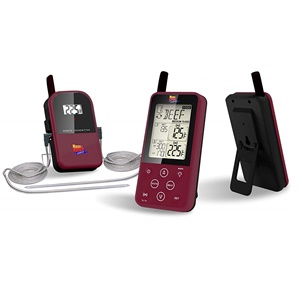 Another Maverick that found a place on our list, but this time a bit heftier and with a slightly more modern design, colored in red and black. The set contains 2 stainless steel sensor probes with grill clips, a small transmitter device, and a larger receiver device.
Another Maverick that found a place on our list, but this time a bit heftier and with a slightly more modern design, colored in red and black. The set contains 2 stainless steel sensor probes with grill clips, a small transmitter device, and a larger receiver device.
By adding a receiver module with radio frequency communication, they achieved an average range of 300 feet. You can read a single probe temperature from the transmitter, or both at the same time from the receiver LCD screen. The screen on the receiver is backlit, and it lets you pick and choose from a wide range of programs, including different meat programs, and different grilling and smoking styles. You can also switch between Fahrenheit and Celsius temperature scales with a press of a button.
There is also an alarm option installed to remind you that the wanted temperature is achieved, or that the meat is done.
8. Tenergy Solis Digital Meat Thermometer
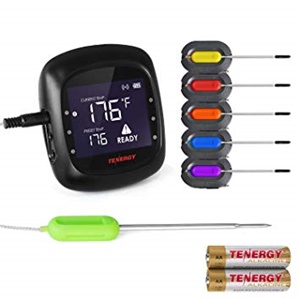 Now comes the only model on our list that provided a whole set of 6 probes. This Solis model is small and compact, with modern and digital design and a black color finish. The set contains 6 stainless-steel color-coded sensor probes, a transmitter, and a hard-shell carrying case.
Now comes the only model on our list that provided a whole set of 6 probes. This Solis model is small and compact, with modern and digital design and a black color finish. The set contains 6 stainless-steel color-coded sensor probes, a transmitter, and a hard-shell carrying case.
After you connect the transmitter to your mobile phone or tablet, using Bluetooth technology, of course, you get to customize the settings of the thermometer. Every piece of sensor info is available via the application, and the range you can reach is about 100 feet. There are preprogrammed settings for different meats, and a custom one for you to set your own cooking duration or wanted temperature timer.
These probes can measure the temperature in the 32-572 degrees Fahrenheit range, and with six of them, you will have all the corners of the grill covered in no time.
9. Chugod Remote Meet Cooking Thermometer
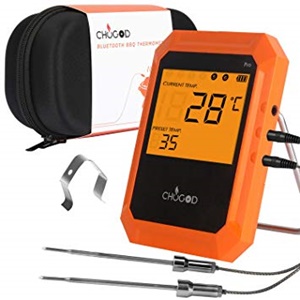 And the very last model on our list is another Bluetooth connected thermometer from Chugod. It is industrially designed, with a black and orange finish. The set contains 2 stainless steel probes, a transmitter module that supports up to 6 probes, and a carrying case.
And the very last model on our list is another Bluetooth connected thermometer from Chugod. It is industrially designed, with a black and orange finish. The set contains 2 stainless steel probes, a transmitter module that supports up to 6 probes, and a carrying case.
This unit has a powerful transmitter module that supports up to 6 probes and comes equipped with a backlit LCD screen that allows you to monitor a single probe at a time. The rest is done via the mobile phone or tablet app, which you can use to set different timers for each probe or to just pick a program for the kind of meat you are currently grilling or smoking. Even though a phone is needed to unlock the full potential of this thermometer, the transmitter module can stand on its own, and help you with rocking.
The temperature range these probes accurately measure is from 32 to 572 degrees Fahrenheit, with the maximum rating of 716.
What Is a Wireless Meat Thermometer?
Even though the name is quite self-explanatory, digital thermometers (wireless and non-wireless) are not just any kind of simple technology. As a matter of fact, wireless meat thermometers are a combination of several modern tech solutions that guide the process from the sole point of measuring heat to sending smartphone notifications. To some, this might even sound like a sci-fi movie, but at its core, this technology is solid and tested out millions of times over the last few decades.
The main three components of any wireless meat thermometer are:
1. The probes
Also known as sensors, probe sensors, or pins, these are the essential part of any heat-measuring set. They are made of highly resistant, noncorrosive materials (in most cases, steel), and they are the part that is doing the measuring inside a grill or a smoker. Many say that mastering the heat measuring actually lies in mastering the probes themselves (position, depth, angle). More about that in the sections to come.
2. The transmitter
This is the core of any wireless meat thermometer. It is where the other end of the probe goes, passing the temperature info. The transmitter is usually equipped with an LCD screen, a set of control buttons and a transmitting module. The controls are used to set a timer, wanted temperature or to program any special features a thermometer can have. The transmitter module is usually hidden and its main purpose is to connect to a receiver and convey temperature status.
3. The receiver
Generally speaking, the receiver is a piece of tech that is wirelessly connected to the transmitter. Now, here we can split receiver types into 2 groups:
- Standard radio receiver: a device that comes with the thermometer. It is designed to look simple and to only fulfill the role of informing you about temperatures and timers.
- Smartphone as a receiver: Some models of thermometers use Bluetooth technology to connect to your personal mobile phone. Everything can be controlled from the phone, and all notifications and timers are sent to your phone directly.
How Does a Digital Meat Thermometer Work?
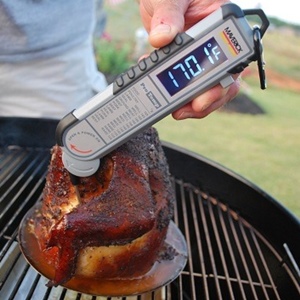 Judging by the look and feel of different thermometer models, one could easily conclude that there are many types and sorts of wireless thermometers. The truth is that every thermometer works by the same principle. The technology behind it is amazing, but it does not differ that much from model to model.
Judging by the look and feel of different thermometer models, one could easily conclude that there are many types and sorts of wireless thermometers. The truth is that every thermometer works by the same principle. The technology behind it is amazing, but it does not differ that much from model to model.
We have talked about the main parts every thermometer has, and that does cover the basics of it. But let’s talk about the intricate details, like probe placement, or temperature programming. These devices certainly have a lot to offer, and the better you get to know how they work, the tastier the steaks are going to be on the next cookout.
The models vary in shape and size, but there is no difference in their temperature-measuring mechanisms. So, for the sake of simplicity, we are going to split the whole process into parts.
1. Probing the meat
We have mentioned before that proper handling of the probes makes you a far better cook, and we meant it. Wireless meat thermometers, on average, have 1-6 probes available. Each probe measures the temperature around it separately and reports it back to the transmitter. Now, the essential thing to remember is how and where you set the probes. By testing the temperature of the meat only, you will not get all the info needed.
Let’s talk about the ideal scenario. For this you will need 3 probes:
- Meat probe: inserted into the middle, softest part of the piece of meat that is currently smoked/grilled. This gives you an idea of when the meat is done, and how rare it is.
- Grill grate probe: This probe is to be attached one inch above the grill grate. Use the provided clip to do it, or improvise with some aluminum foil (just make sure not to cover the tip of the sensor)
- Inner grill probe: this probe will tell you when to start cooking, and it is the first one to be attached when setting up the meat thermometer. Attach it to the inside walls of the grill, approximately in the middle, above the meat.
Extra sensor probes are there to be used on different meats, or on other parts of the same piece for extra heat control. The more data you gather about the heat, the better.
2. The thermometer
After the data is gathered by the probes, it is sent (via highly durable cables) to the transmitter module. Most models have an instant-read monitor on this module, so you can see what the temperature is in any given moment. This part is usually stationed somewhere around the grill itself, and its most important role is to send the status of the grill to the receiver.
3. Programming the receiver
So, we have already established that the role of a receiver is fulfilled either by a standard radio receiver provided with the rest of the gear or by a smartphone using Bluetooth. No matter which one you have, there are always some basic features and options that are done through the receiver. Here are some of the main options:
- Reading direct temperature
- Setting a timer, and making the receiver sound an alarm at the given time
- Setting a pre-programmed cycle for different kinds of meat
- Sending info to your smartphone, and editing programs if needed
All of these features feel quite intuitive to learn and use, especially on a smartphone. Just set the temperature you want, and go do some chores, the transmitter will send a notification when the desired time or temperature is achieved. There are some great extra features that come with these, but more about those later.
Wireless Meat Thermometer Buying Guide
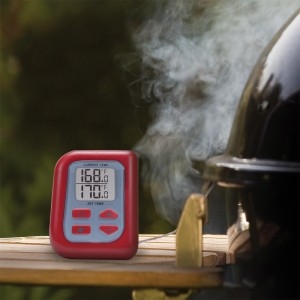 So far, we have covered the working mechanisms, basic features, and advantages of using a wireless thermometer. They have a lot to offer, even in their most basic form. Do not think for a second there that you can sense the grill temperature better than one of these devices. Even the greatest chefs will tell you that having precise temperature info brings the best out of food. Let’s be honest, if you just eyeball your grill temperatures while cooking and a steak goes well done (instead of medium or rare), most likely you got it wrong.
So far, we have covered the working mechanisms, basic features, and advantages of using a wireless thermometer. They have a lot to offer, even in their most basic form. Do not think for a second there that you can sense the grill temperature better than one of these devices. Even the greatest chefs will tell you that having precise temperature info brings the best out of food. Let’s be honest, if you just eyeball your grill temperatures while cooking and a steak goes well done (instead of medium or rare), most likely you got it wrong.
It would be best to think about wireless thermometers as a regular piece of grilling equipment and gear, together with spices, coal, meat, oils, and so on. Having a super expensive kamado can be all for naught if you do not master the heat it produces. So, now it is time to dive into all the specifications you can (and should) look for, depending on the requirements you have. This next section is there to help you create a list of things and features you want, and of those you need, furtherly allowing you to improve the quality of the food you cook.
1. Probes – How much and what kind?
Considering the fact that we are talking about sensor probes for the third time, you surely guessed that they are the most essential part of any thermometer. These sensors are the ones doing the measuring inside the heated chamber of your grill or smoker, so pay extra attention when picking the thermometer that meets your requirements. Here are some things to look for when making a decision:
1.1 Number of probe sensors
If you mostly cook pork or poultry, a couple of probes will be sufficient to cover your basic needs. You have to measure the temperature of the grill insides and the temperature of the meat. Add another sensor to measure the temperature of the grill grate, and you are all set to make that delicious juicy meat for your family. Adding an extra probe is also good for cooking chicken because we all know that it must never be undercooked, and according to the FDA, the minimum temperature must be at least 165 degrees Fahrenheit. With poultry, it is always better to be safe than sorry.
Now, for all you steak enthusiasts out there, having additional probes is almost considered a must. To be fair, you can achieve any kind of steak rareness with a single probe, but that would require you to stay by the grill and do a lot of sensor relocations. To cook a steak properly, or slow cook it, the ideal number of probes would be four. This is how to spread the sensor coverage:
- One goes inside the grill, higher above the grill grate (aim for the middle)
- Get a clip and measure the temperature one inch above the grill grate
- First food probe goes deep inside the steak
- Second food probe goes on the surface of the meat (upper surface)
Any extra sensors you can get are great for a couple of things like making different meats at the same time, measuring the temperature on different spots, or basically taking any kind of extra measurement you would like to have. Some people even like to measure the temperature of the coal chamber below the grill grate, just to have a sort of “heads up” when it comes to slow cooking.
1.2 Sensor probe quality
There is little deviation from the standard when it comes to the quality of each probe, no matter the model. The best ones are made of steel and are connected to a fire-resistant cable. The length of this cable also varies, so make sure you check how long you need your cables to be.
Another thing to pay attention to would be the rating of the sensor needle. This practically tells you the highest temperature you can expose the probe to, and while this also varies, most go over 650 degrees Fahrenheit. Just make sure to never reach the bare maximum when it comes to temperature.
And the last thing regarding the quality of the probes you should consider is the connectivity. No, we are not talking about the wireless technology, but the sockets on the transmitter that you plug the probe cables into. These can often feel loose, so you want your model to have the tight ones.
2. Transmitter, what to look for?
We talked about probes as the essential part of these thermometers, however, when it comes to wireless technology, you ought to look for a good transmitter. This piece of the whole apparatus is there to gather the heat data from the probes (hence the probe cable sockets found on it), and to pass it to the receiver.
The first thing you should look for if you intend to stay outside for the whole duration of the cookout is a monitor screen on the transmitter unit. The receiver will surely have one, of course, but if you are standing by the grill, there is no need to hold 2 separate devices for the same purpose. If this monitor has a backlight, even better.
Another crucial thing to check is the type of wireless connection the transmitter is making. There are two major types of connection: radio and Bluetooth. Now, if the model comes with its own receiver, it would be best to go for the radio wave transmission. This type of data transfer has a wider range, almost double what Bluetooth can offer. If your phone is to act as a receiver, you are probably stuck with the Bluetooth connection, which is not all that bad, but has a narrower range than radio, and doesn’t win against obstacles like walls very well. Which takes us to the next point:
3. Receiver programming
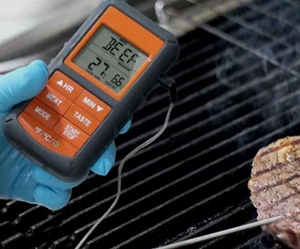 This is where the mastery of wireless grill thermometers lies. Most models will offer a standard set of features:
This is where the mastery of wireless grill thermometers lies. Most models will offer a standard set of features:
- Timer and/or alarm to notify you when the wanted temperature or time is achieved
- Live temperature tracker for each probe
- Option to preset the temperature and make your own program
- Dual temperature scale mode (Fahrenheit to Celsius and vice-versa).
This set of features will be just enough to cover the essentials and teach you how to achieve the best results every time you grill. However, some people like to smoke their meat for a long time or even grill it in strictly controlled conditions, following a special recipe. In this case, you will want to take a thermometer that comes with additional programs like:
- Poultry roasting
- Slow cooking
- Smoking different meats with a program for each type of meat (poultry, pork, fish, beef, venison)
- Grilling different types of meat simultaneously
These programs are often written by experienced grill chefs and are always made to follow food regulations regarding health and fire safety.
Let’s say that you want to make three different steaks: one well-done, one rare, and one medium-rare. You want to cook them at the same time for you and your 2 guests. Well, with separate probes and a good program you are able to do that, without having to check on every steak each minute, fearing that it will overcook.
4. Additional accessories
They say that there are no two same grill cooks in the world and that every single one has their own little unique habits and quirks. If you want to unlock the full potential of your recipes, and level up your cooking skills, some additional accessories may help by making your cooking sessions more convenient in small, yet significant ways.
4.1 Probe handles, clamps and alligator clips
The very first thing you will have to learn is how to set up the probes. As we learned before, some probes are set into high heat zones, and they need to stay there until the end. That is why you will quickly learn to appreciate a good clip or a clamp. These much-needed accessories are made to withstand the same high temperatures that sensors do. If you can get your hands on a pair of good alligator clips, the future you will be ever grateful.
4.2 Oven handles and adapters
Besides measuring the burning fires of top-rated small grills or best offset smokers, there is no reason why you shouldn’t use your wireless thermometer to control the temperature of your oven. The built-in temperature indicators on ovens are known to make a mistake by tens of degrees Fahrenheit, and now you have the chance to measure and correct that accordingly. Some thermometer models come with oven adapters that are used as connectors between the oven grate and the probe. Also, if you wish so, you can put some probes inside that pie, and see how well it is advancing towards that perfect crunchy crust.
5. Holding mechanism
This may come as a surprise, but most of the transmitters and the receivers are not that heat or liquid resistant. That is why some models come with some kind of a mechanism allowing you to stick or hang them on the wall or any convenient nearby surface. Some come with Velcro type sticking mechanisms, others with additional handles, or some other similar system.
It is important to place it somewhere you can easily read the temperature from, without the risk of greasing the device up, or making it wet.
FAQ About Instant Read Meat Thermometers
1. What kind of mobile phone do I need if I want to use it as a receiver?
When it comes to wireless thermometers and their connectivity, this is the most common question. To put the answer simply: if the manufacturer made the model to be able to connect to your phone, any iOS or Android phone (Android 4.4 and higher) will do. There aren’t any special requirements, besides downloading the needed app from the AppStore (for Apple) or Play Store (for Android users).
2. How and when should I properly clean the sensor probes?
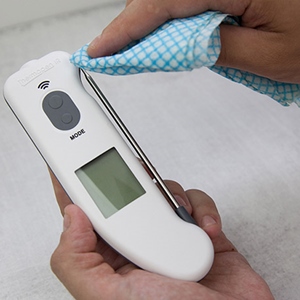 Some people insist on thorough probe cleaning before and after each use. However, that can sometimes be a bit too much. The most important thing to remember is cleaning the sensors after use. Now, there is no ideal way to clean them, but we recommend alcohol swabs or rubbing alcohol and a soft cloth.
Some people insist on thorough probe cleaning before and after each use. However, that can sometimes be a bit too much. The most important thing to remember is cleaning the sensors after use. Now, there is no ideal way to clean them, but we recommend alcohol swabs or rubbing alcohol and a soft cloth.
Make sure to avoid any abrasive cleaning agent or any organic agent based on some kind of a benzene byproduct. This may permanently damage the probe tips. Also, benzene-based cleaners are known to be toxic to some degree, so the safest bet is to avoid them. After you are done cleaning the probes, use a soft cotton cloth to dry them, and immediately store them for safe keeping.
3. Are smoking and long cooking programs safe to be left overnight, or during the whole day?
Absolutely! These programmed devices excel at long smoking sessions and are made to fulfill your needs for as long as you need them. However, even though the manufacturers sometimes state that you do not need to watch and oversee the smoking process, we advise you to go and check on it now and again. Smoking sessions can even last over 20 hours, so it would be best to make several checks, at least until you get yourself familiarized with the whole process, and the wireless thermometer for smoking as well.
Wrap Up
Investing in grilling equipment should be a pleasurable process, and this guide can help you achieve that. Cooking should be fun and interesting, and not only a set of regulations and precautions. Getting to that juicy steak or smoked fish is not as far away as you might think. If choosing the right meat is a step towards a tasty meal, getting the best wireless meat thermometer for smokers is a leap towards the same goal.
Take some time to study and soak up all the important info we presented in this guide. Make a checklist and go find a perfect thermometer for your grill, thus making anyone that eats your specialties satisfied. Using modern technology to enhance traditional thousand-year-old values is a great way to start.
If by any chance we missed something, or you have something to add or ask, feel free to do so in the comment section below, and we will gladly provide an answer.
